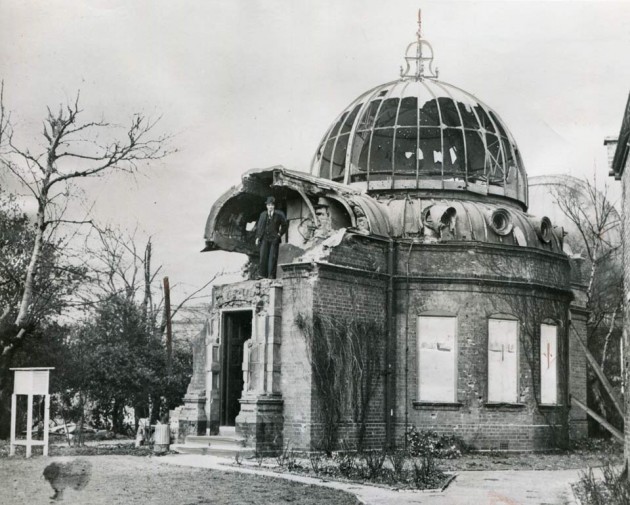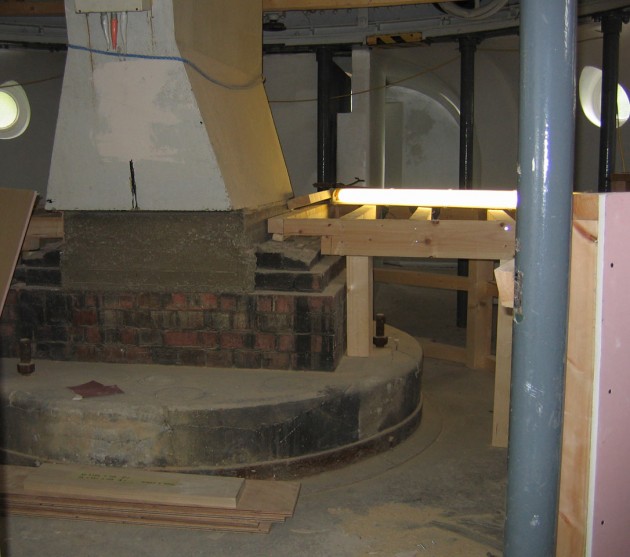…where east meets west
- Home
- Brief History
- The Greenwich Meridian
- Greenwich
(1675–1958) - Herstmonceux
(1948–1990) - Cambridge
(1990–1998) - Outstations (1822–1971)…
- – Chingford (1822–1924)
- – Deal
(1864–1927) - – Abinger
(1923–1957) - – Bristol & Bradford on Avon
(1939–1948) - – Bath
(1939–1949) - – Hartland
(1955–1967) - – Cape of Good Hope
(1959–1971)
- Administration…
- – Funding
- – Governance
- – Inventories
- – Pay
- – Regulations
- – Royal Warrants
- Contemporary Accounts
- People
- Publications
- Science
- Technology
- Telescopes
- Chronometers
- Clocks & Time
- Board of Longitude
- Libraries & Archives
- Visit
- Search
Small Transit Telescope by Cooke, Troughton & Simms (originally ordered for Singapore)
Acquired during the reporting year 1939/40 (1 May 1939 – 30 April 1940), the telescope was installed in the Altazimuth Pavilion. Mounted on a brick pier specially constructed for it on top of the existing pier, it replaced Christie’s Altazimuth Telescope, which was removed to make way for it.
The telescope ‘was broken in half when thrown from its mounting’ when the Pavilion was struck by enemy action on the night of October 21/22 October 1940, though the object glass was undamaged.
The impersonal micrometer that had belonged to the instrument was fitted to the Bamberg Broken Transit in the reporting year 1946/7 prior to that instrument being brought into use with the Time Service at Abinger.
Origin and proposed use of the telescope
The origin and proposed use of the telescope was described by Spencer Jones in his 1940 Annual Report to the Board of Visitors. It has been transcribed below:
‘A small transit Instrument made by Messrs. Cooke, Troughton and Simms Ltd. has been purchased from the Crown Agents for the Colonies. This instrument was constructed for time determinations at Singapore but was not used as it found that time to a sufficient degree of accuracy could be obtained by recording time signals from various countries. The instrument is of more modern design than the small transit instruments hitherto used as [at] the Observatory, which were constructed for use by expeditions to observe the Transit of Venus in 1874. After thorough overhaul In the workshop and the fitting of a new contact wheel to the impersonal micrometer, to change from a. ‘make’ to a ‘break’ circuit, the telescope was mounted in the the Altazimuth dome. A personal equation machine is under construction in the workshop and will be fitted to the south collimator [of the Altazimuth]. An artificial star will be travelled along in either direction by a geared reversible motor; a gear box is provided to enable the star to be moved at a rate corresponding to the speed of an equatorial star, or to one-half or one-quarter of that speed. The north collimator will be used to provide a check on the stability in azimuth of the telescope. It is hoped that observations with the two small transit instruments [this one and the one used for time determinations in the Transit Pavilion] on the same night, in conjunction with observations with the Reversible Transit Circle, will give some information about fluctuating errors of instrumental origin.’

The bomb damaged Altazimuth Pavilion in December 1940. The damaged brickwork and terracotta have been removed, but the south portico is still open to the elements. The photo was published, along with those of other bomb damaged buildings in Bristol, Windsor and elsewhere in the 14 December edition of The Illustrated London News

The circular concrete structure is the top of the original Altazimuth pier (complete with bolts). The brickwork on top is what remains of the pier built for the small transit instrument(s). The concrete pier was installed in the 1960s for the Sheepshanks Equatorial. It was later used for the Photoheliograph and Newbegin Refractor. Since 2018, it has supported the 'Annie Maunder Astrographic Telescope'. Photo: June 2006
© 2014 – 2025 Graham Dolan
Except where indicated, all text and images are the copyright of Graham Dolan